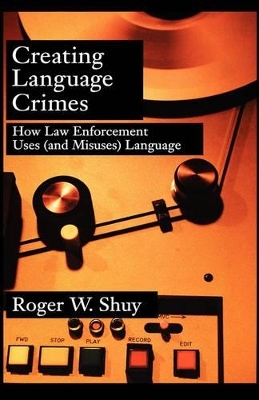
Creating Language Crimes
Oxford University Press Inc (Verlag)
978-0-19-518166-1 (ISBN)
This book by Roger W. Shuy, the senior figure in forensic linguistics, is the first to explain in an accessible way the vital role that linguistic evidence and its proper analysis play in criminal investigations. Shuy provides compelling case studies of how language functions in investigations involving, among others, wired undercover operatives, and the interrogation of suspects. He makes the point that language evidence can be as important as physical evidence, but yet does not enjoy the same degree of scrutiny by investigators, attorneys, and the courts. Beyond this, however, his more controversial thesis is that police frequently misuse or manipulate language, using various powerful controversial strategies, in order to intentionally create an impression of the targets' guilt or even to get them to confess. attorneys, law enforcement officers, judges, and juries This book makes its case by analyzing a dozen criminal cases involving a variety of crimes, such as fraud, bribery, stolen property, murder, and others. About half involve co-operating witnesses who do the tape recording, and the other half undercover police officers. These cases demonstrate how undercover operatives use different conversational strategies, such as overlapping conversation, ambiguity, interruption, refusing to take "no" for an answer, and others to create a negative impression of the targets on later listeners. Creating Language Crimes provides a fascinating window into a little-known and discussed facet of law enforcement. It will appeal to anyone concerned with language (particularly sociolinguists and discourse analysts), as well as to those involved in law enforcement and criminal cases. the appearance of such crime is created, law enforcement has not reached its evidentiary goal. Eleven conversational strategies were used in the twelve actual criminal cases described in this book.
Roger W. Shuy is Distinguished Research Professor of Linguistics, Emeritus, at Georgetown University. He is also president of Roger W. Shuy, Inc. in Missoula, Montana, founded in 1982 and specializing in linguistic services to attorneys in criminal and civil cases.
Introduction
Part I: Crimes, Conversational Strategies, and Language Power
1: How Language Crimes Are Created
2: Conversational Strategies Used to Create Crimes
3: The Power of Conversational Strategies
Part II: Uses by Cooperating Witnesses
4: Overlapping, Ambiguity, and the Hit and Run in a Solicitation to Murder Case: Texas v. T. Cullen Davis
5: Retelling, Scripting, and Lying in a Murder Case: Florida v. Alan Mackerley
6: Interrupting, Overlapping, Lying, Not Taking "No" for an Answer, and Representing Illegality Differently to Separate Targets in a Stolen Property Case: US v. Prakesh Patel and Daniel Houston
7: Eleven Little Ambiguities and How They Grew in a Business Fraud Case: US v. Paul Webster and Joe Martino
8: Discourse Ambiguity in a Contact Fraud Case: US v. David Smith
9: Contamination and Manipulation in a Bribery Case: US v. Paul Manziel
10: Scripting by Requesting Directives and Apologies in a Sexual Misconduct Case: Idaho v. J. Mussina
Part III: Uses by Law Enforcement Officers
11: Police Camouflaging in an Obstruction of Justice Case: US v. Brian Lett
12: Police Camouflaging in a Purchasing Stolen Property Case: US v. Tariq Shalash
13: A Rogue Cop and Every Strategy He Can Think Of: The Wenatchee Washington Sex Ring Case
14: An Undercover Policeman Uses Ambiguity, Hit and Run, Interrupting, Scripting, and Refusing to Take "No" for an Answer in a Solicitation to Murder Case: The Crown v. Mohammed Arshad
15: Manipulating the Tape, Interrupting, Inaccurate Restatements, and Scripting in a Murder Case: Florida v. Jerry Townsend
Part IV: Conversational Strategies as Evidence
16: Eight Questions about the Power of Conversational Strategies in Undercover Police Investigations
References Cited
Cases Cited
Index
| Erscheint lt. Verlag | 13.10.2005 |
|---|---|
| Verlagsort | New York |
| Sprache | englisch |
| Maße | 148 x 217 mm |
| Gewicht | 363 g |
| Themenwelt | Geisteswissenschaften ► Sprach- / Literaturwissenschaft ► Sprachwissenschaft |
| Recht / Steuern ► EU / Internationales Recht | |
| Recht / Steuern ► Privatrecht / Bürgerliches Recht ► Berufs-/Gebührenrecht | |
| Recht / Steuern ► Strafrecht ► Kriminologie | |
| ISBN-10 | 0-19-518166-2 / 0195181662 |
| ISBN-13 | 978-0-19-518166-1 / 9780195181661 |
| Zustand | Neuware |
| Informationen gemäß Produktsicherheitsverordnung (GPSR) | |
| Haben Sie eine Frage zum Produkt? |
aus dem Bereich


